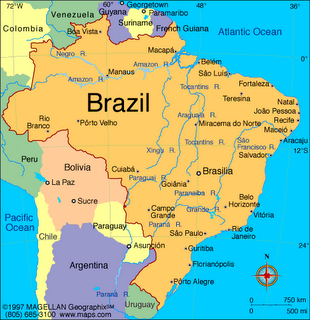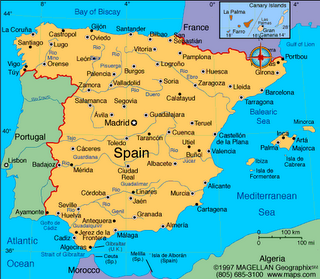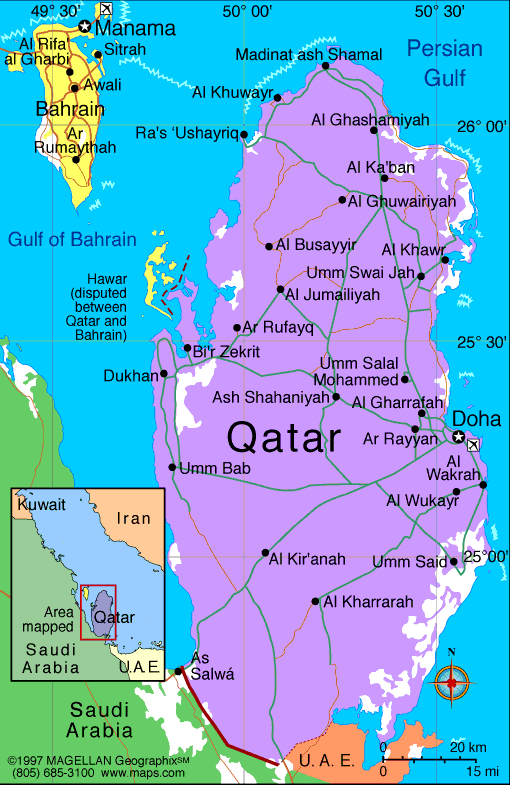
SudanRepublic of Sudan, republic (1995 est. pop. 30,120,000), 967,494 sq mi (2,505,813 sq km), NE Africa. The largest country in Africa, it borders on Egypt in the north, on the Red Sea in the northeast, on Eritrea and Ethiopia in the east, on Kenya, Uganda, and Congo (Kinshasa) in the south, on the Central African Republic and Chad in the west, and on Libya in the northwest. Khartoum is the capital and Omdurman is the largest city. 1
LandThe main geographical feature of Sudan is the Nile River, which, with its tributaries (including the Atbara, Blue Nile, and White Nile rivers), traverses the country from south to north. The Nile system provides irrigation for strips of agricultural settlement for much of its course in Sudan and also for the Al Gezira plain, situated between the White Nile and the Blue Nile, just south of their confluence at Khartoum. In the extreme north, the Nile broadens into Lake Nasser, formed by the Aswan High Dam in Egypt. 2
Much of the rest of the country is made up of an undulating plateau (1,000–2,000 ft/305–610 m high), which rises to higher levels in the mountains located in the northeast near the Red Sea, as well as in the central, western, and extreme southern portions of the country. The highest point in Sudan is Kinyeti (10,456 ft/3,187 m), in the southeast. Rainfall diminishes from south to north in Sudan; thus, the south is characterized by swampland (the Sudd region) and woodland, the center by savanna and grassland, and the north by desert and semidesert. Sudan is divided into 26 states. 3
People
The inhabitants of Sudan are divided into three main groups. The northerners, who inhabit the country roughly north of 12°N lat. and mainly near the Nile, consist of Arab and Nubian groups; they are Muslim (mostly of the Sunni branch), speak Arabic (the country’s official language), and follow Arab cultural patterns (although only relatively few are descended from the Arabs who emigrated into the region during the 13th–19th cent.). The westerners, so called because they immigrated (primarily in the 20th cent.) from W Africa, are also Muslim, live mostly in the central part of Sudan, and work as farmers or agricultural laborers. The southerners, consisting of Nilotic and Sudanic peoples, largely follow traditional religious beliefs, although some are Christian; they practice shifting cultivation or are pastoralists, and most speak Nilotic languages. The leading ethnic groups in the south are the Dinka, Nuer, Shilluk, Bari, and the non-Nilotic Azande. 4
The great majority of the country’s population live in villages or small towns; the only sizable cities are Port Sudan, Wad Madani, Al Ubayyid, and the conurbation of Khartoum, Omdurman, and Khartoum North. The desert and semidesert of the north are largely uninhabited. Since the late 1970s, there have been waves of refugees from neighboring countries, a result of political, environmental, and economic problems in the region. Many have settled in the area around Khartoum. However, since the 1980s there has also been outmigration due to the civil war in the south. Educational facilities are very limited, marked by low literacy rates. The main institutions of higher education are the Univ. of Khartoum, the Khartoum branch of the Univ. of Cairo, Juba Univ., Gezira Univ., and Omdurman Islamic Univ. 5
Economy
Sudan is an overwhelmingly agricultural country. Much of the farming is of a subsistence kind; in the late 1990s agriculture occupied some 80% of the workforce but contributed only 33% of the GDP. Agricultural production varies from year to year because of intermittent droughts that cause widespread famine. The government plays a major role in planning the economy. The leading export crops are cotton, sesame, and peanuts. Other agricultural products include sorghum, millet, wheat, dates, and sugarcane. Sheep, cattle, goats, and camels are raised. A variety of forest products are produced, by far the most important being gum arabic, with Sudan accounting for much of the total world production. In the south, fish caught in the Nile system are an important dietary staple. The leading products of the country’s small mining industry are chromite, copper, salt, gold, manganese, gypsum, and mica. Petroleum deposits were developed in the 1970s, but the work was discontinued in the mid-1980s as military conflict in the south intensified. In the late 1990s, the government sought foreign partners to help redevelop the oil sector, and a pipeline was built from S Sudan to Port Sudan, on the Red Sea. 6
Industry is largely confined to agricultural processing and the manufacture of basic consumer needs; the chief products include ginned cotton, processed food, beverages, textiles, cement, soap, and footwear. Petroleum is also refined, but the main source of energy is hydroelectric power. The country has a very limited transportation network. Foreign trade is largely conducted via Port Sudan. Chief among the annual imports, the value of which is usually higher than that of exports, are food, petroleum products, machinery, transportation equipment, medicines, chemicals, and manufactured goods; the principal exports are ginned cotton, sesame, gum arabic, livestock, and meat. The leading trade partners are Saudi Arabia, the United Kingdom and other European Union countries, China, and South Korea. 7
History
Early History
Northeast Sudan, called Nubia in ancient times, was colonized (c.2000 B.C.) by Egypt as far as the fourth cataract of the Nile (near modern Karima). From the 8th cent. B.C. to the 4th cent. A.D. this region was ruled by the Cush kingdom, centered first at Napata (near the fourth cataract) and after c.600 B.C. at Meroë (between the fifth and sixth cataracts). From c.750 to c.650 B.C., Cush ruled Egypt as a result of a dynastic replacement. Meroë was a center of trade and ironworking, and from there iron technology may have spread to other parts of Africa. 8
Most of the inhabitants of Nubia were converted to Coptic Christianity in the 6th cent. A.D., and by the 8th cent. three states flourished in the area. These states long resisted invasions from Egypt, which had come under Muslim rule in the 7th cent. However, from the 13th to the 15th cent. the region was increasingly infiltrated by peoples from the north; the states collapsed, and Nubia gradually became Muslim. The southern part of the modern Sudan continued to adhere to traditional African beliefs. Much of the north was ruled by the Muslim state of Funj from the 16th cent. until 1821, when it was conquered by armies sent by Muhammad Ali of Egypt. 9
The Era of Foreign Control
The Egyptians founded (1823) Khartoum as their headquarters and developed Sudan’s trade in ivory and slaves. Ismail Pasha (in office 1863–79) tried to extend Egyptian influence further south in Sudan, ostensibly to end the slave trade. This campaign, which was headed first by Sir Samuel Baker and then by Charles Gordon, provoked a complex revolt (1881) by the Mahdi (Muhammad Ahmad), who sought to end Egyptian influence and to purify Islam in Sudan. The Mahdists defeated Anglo-Egyptian punitive expeditions, and Britain and Egypt decided to abandon Sudan. Gordon, sent to evacuate the British and Egyptian troops, was killed by the Mahdists at Khartoum in early 1885. The Mahdi died in the same year, but his successor, the Khalifa Abdallahi, continued to build up the theocratic Mahdist state. 10
In the 1890s the British decided to gain control of Sudan, and, in a series of campaigns between 1896 and 1898, an Anglo-Egyptian force under Herbert (later Lord) Kitchener destroyed the power of the Mahdists. Agreements in 1899 (reaffirmed by the Anglo-Egyptian treaty of 1936) established the condominium government of the Anglo-Egyptian Sudan. Under the condominium, Sudan was administered by a governor-general, appointed by Egypt with the consent of Great Britain; in practice, however, the British controlled the government of Sudan. The Sudanese continued to oppose colonial rule, and the Egyptians resented their subordinate role to the British. 11
In 1924 the British instituted a policy of isolating the southern Sudan by administering it separately from the north. An advisory council for the northern Sudan was established in 1943, and in 1948 a predominantly elective legislative assembly for the whole territory was set up. In the 1948 elections, the Independence Front, which favored the creation of an independent republic, gained a majority over the National Front, which sought union with Egypt. After the 1952 revolution in Egypt, Britain and Egypt agreed to prepare Sudan for independence in 1956. In 1955 southerners, fearing that the new nation would be dominated by the Muslim north, began a revolt that lasted 17 years. 12
Struggles of an Independent Nation
In spite of the continuing revolt in the south, Sudan achieved independence as a parliamentary republic in 1956, as planned. In 1958, Gen. Ibrahim Abboud led a military coup that ended the parliamentary system. Unable to improve the country’s weak economy or to end the southern revolt, Abboud in 1964 agreed to the reestablishment of civilian government. The new regime also had little success in coping with the country’s problems. 13
In 1969, Col. Muhammad Gaafur al-Nimeiry staged a successful coup. He banned all political parties and subsequently nationalized banks and numerous industries. The bloody civil war was ended by an agreement between the government and the Southern Sudan Liberation Front (whose military arm was known as Anya Nya) signed (Feb., 1972) at Addis Ababa. Under the agreement S Sudan was granted considerable autonomy. Also in 1972, the Sudanese Socialist Union, the country’s only political organization, elected a “people’s assembly” to draw up a new constitution for the country, which was adopted in 1973. Nimeiry’s regime became the target of criticism at home because of worsening economic conditions and for its support of Egypt’s part in the Camp David accords with Israel; in the late 1970s, Nimeiry dismissed his cabinet and closed universities in an attempt to quell opposition. 14
During the 1980s, political instability in S Sudan increased, with renewed fighting by the largely Christian and animist Sudan People’s Liberation Army (SPLA). Motivated at least partly by a desire to shore up his popularity in the largely Muslim north, Nimeiry in 1983 instituted strict Islamic law, further inflaming opposition in the south. Having survived numerous earlier coup attempts, he was overthrown in 1985, and Gen. Abdul Rahman Swaredahab was installed as leader of a transitional military government. Elections were held in 1986 and a civilian government led by Sadiq al-Mahdi ruled until it was overthrown in a bloodless coup in 1989. 15
The new military regime under Lt. Gen. Omar Ahmed al-Bashir strengthened ties with Libya, Iran, and Iraq; reinforced Islamic law; banned opposition parties; and continued to pursue the war with the south, diverting relief aid (primarily food) from the famine-stricken south to the Muslim north. In 1990 the United States halted relief efforts to Sudan; ties between the two nations were further strained when Sudan supported Iraq in the Persian Gulf War. Bashir officially became president in 1993, but significant political power was held by the National Islamic Front, a fundamentalist political organization formed from the Muslim Brotherhood and led by Hassan al-Turabi, who became speaker of parliament. In 1996, Bashir won a presidential election that was boycotted by most opposition groups; a multiparty system was restored in 1999. 16
In Aug., 1998, U.S. missiles destroyed a pharmaceutical plant in Khartoum that was suspected of manufacturing chemical-weapons compounds to be used in terrorist activities; however, international investigators were unable to find evidence to support the charges. Civil war continued through the 1990s, by which time it had reportedly resulted in nearly 2 million deaths (mostly from war-related starvation and disease) and had left the economy crippled. Sudan was cited by the UN Human Rights Commission for human-rights violations (including alleged widespread slavery and forced labor), condemned for supporting terrorism abroad, and accused by human-rights groups of “ethnic cleansing” in its offensive against the south. A cease-fire was declared in July, 1998, in order to allow food shipments to be delivered, but there were violations. In July, 1999, peace talks in Nairobi, Kenya, broke down as the warring sides failed to renew the cease-fire. 17
During 1999 the parliament increased Turabi’s powers and moved to limit those of the president. In response, Bashir declared a three-month state of emergency in December and dissolved parliament; the next month he appointed a new cabinet. Bashir also improved his position in the ruling National Congress party. In May, 2000, Turabi’s position as secretary-general of the party was frozen, and Turabi subsequently formed his own party, the Popular National Congress party. 18
Meanwhile, Bashir’s government worked to improve its foreign relations, and, in December, Bashir was reelected president. The opposition boycotted the vote, and the concurrent parliamentary elections were swept by the National Congress party. In Feb., 2001, Turabi was placed under house arrest after signing a memorandum of understanding with the southern rebels in which they called for joint peaceful resistance to Bashir’s government, and subsequently other members of Turabi’s political party were arrested; Turabi was not released until Oct., 2003. In Jan., 2002, a cease-fire was declared in the ongoing civil war in the Nuba Mts. to allow relief aid to be distributed in the drought-stricken south-central region, but fighting continued elsewhere. The same month two rebels groups, the Sudan People’s Liberation Army (SPLA) and Sudan People’s Defense Force, established a formal alliance. 19
The government and the SPLA agreed to a framework for peace in July, 2002; however, three regions of central Sudan claimed by the rebels were not covered by the agreement. A broad truce was agreed to in Oct., 2002. Despite some violations of the cease-fire, talks continued in 2003. In Sept., 2003, an accord between the two sides called for the withdrawal of government troops from the south, rebel forces from the north, and the establishment of a joint government-rebel force in the south and in two central regions, and talks continued. Additional protocols were signed in May, 2004. 20
In 2003 a separate rebellion broke out in the Darfur region of W Sudan; it involved a group linked to an opposition party. A cease-fire was signed in Sept., 2003, but fighting continued. The Darfur rebels subsequently agreed to form alliance with the Beja rebels in NE Sudan (around Kasala) if they were not included in any settlement with the government; the Beja group had expected to be part of the negotiations with the southern rebels. 21
Militias allied with the government in Darfur (and the government itself) were accused of ethnic cleansing, and many Sudanese were displaced by the fighting, some of them fleeing to Chad. A new cease-fire was signed in Apr., 2004, but it too did not hold. Also in April, Turabi and members of his party were again arrested by the government, which accused them of plotting against it; in September the government asserted that a new coup plot involving the jailed Turabi had been uncovered. 22
There was increasing pressure in mid-2004 from the United Nations, United States, and European Union on Sudan to end the attacks in Darfur, and in July, 2004, Bashir’s government promised the United Nations that it would disarm the militias. A lack of significant progress in ending the fighting and disarming the militias led to UN Security Council resolutions against Sudan in July and September. The latter resolution called for an investigation into whether the attacks were genocide, as U.S. Secretary of State Colin Powell had charged; investigating commission ultimately termed various attacks war crimes and crimes against humanity but not genocide. By early 2005 it was estimated that 2 million had been displaced by the conflict in Darfur. An African Union-sponsored peace accord in Nov., 2004, failed to hold when a new offensive was sparked by a rebel attack later the same month. Meanwhile, there were attacks against Sudanese in the south by the Lord’s Resistance Army (LRA), a Ugandan rebel group, leading both southern Sudanese rebels and government-allied militias to mount a drive against the LRA. 23
Additional protocols relating to peace with the SPLA were signed in early in Jan., 2005, and shortly thereafter a final peace agreement was sealed. The deal called for Islamic law to be restricted to the north, for the south to be autonomous and hold a vote on independence in 2011, and for central government power and southern oil revenues to be shared. Later in January the government signed a preliminary peace agreement with the National Democratic Alliance, an umbrella organization that embraces more than a dozen opposition groups, including the SPLA. 24
Bibliography
See P. M. Holt, A Modern History of the Sudan (3d ed. 1979); R. O. Collins, Shadows in the Grass: Britain in the Southern Sudan, 1918–1956 (1983); N. O’Neill and J. O’Brien, Economy and Class in the Sudan (1988); J. O. Voll, ed., Sudan (1991); P. Woodward, Sudan, 1898–1989 (1991); J. M. Burr, Africa’s Thirty Years’ War: Chad, Libya, and the Sudan, 1963–1993 (1999); D. Petterson, Inside Sudan (1999).






